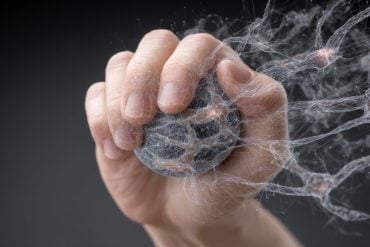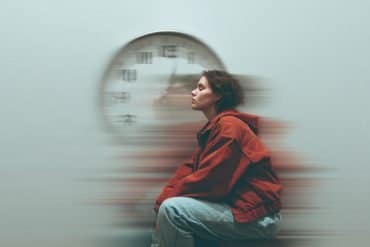Summary: Researchers report the size of the pupil fluctuates during sleep. The findings may indicate that pupile size can indicate specific sleep states.
Source: Cell Press.
When people are awake, their pupils regularly change in size. Those changes are meaningful, reflecting shifting attention or vigilance, for example. Now, researchers reporting in Current Biology on January 18 have found in studies of mice that pupil size also fluctuates during sleep. They also show that pupil size is a reliable indicator of sleep states.
“We found that pupil size rhythmically fluctuates during sleep,” says Daniel Huber of the University of Geneva in Switzerland. “Intriguingly, these pupil fluctuations follow the sleep-related brain activity so closely that they can indicate with high accuracy the exact stage of sleep–the smaller the pupil, the deeper the sleep.”
Studies of pupil size had always been a challenge for an obvious reason: people and animals generally sleep with their eyes closed. Huber says that he and his colleagues were inspired to study pupil size in sleep after discovering that their laboratory mice sometimes sleep with their eyes open. They knew that pupil size varies strongly during wakefulness. What, they wondered, happened during sleep?
To investigate this question, they developed a novel optical pupil-tracking system for mice. The device includes an infrared light positioned close to the head of the animal. That invisible light travels through the skull and brain to illuminate the back of the eye. When the eyes are imaged with an infrared camera, the pupils appear as bright circles. Thanks to this new method, it was suddenly possible to track changes in pupil size accurately, particularly when the animals snoozed naturally with their eyelids open.
Their images show that mouse pupils rhythmically fluctuate during sleep and that those fluctuations are not at all random; they correlate with changes in sleep states.
Further experiments showed that changes in pupil size are not just a passive phenomenon, either. They are actively controlled by the parasympathetic autonomic nervous system. The evidence suggests that in mice, at least, pupils narrow in deep sleep to protect the animals from waking up with a sudden flash of light.

“The common saying that ‘the eyes are the window to the soul’ might even hold true behind closed eyelids during sleep,” Özge Yüzgeç, the student conducting the study, says. “The pupil continues to play an important role during sleep by blocking sensory input and thereby protecting the brain in periods of deep sleep, when memories should be consolidated.”
Huber says they would like to find out whether the findings hold in humans and whether their new method can be adapted in the sleep clinic. “Inferring brain activity by non-invasive pupil tracking might be an interesting alternative or complement to electrode recordings,” he says.
Funding: This research was supported by the Swiss National Science Foundation, the European Research Council. The New York Stem Cell Foundation, and the International Foundation for Paraplegia Research.
Source: Joseph Caputo – Cell Press
Publisher: Organized by NeuroscienceNews.com.
Image Source: NeuroscienceNews.com image is credited to Daniel Huber, University of Geneva.
Original Research: Full open access research for “Pupil Size Coupling to Cortical States Protects the Stability of Deep Sleep via Parasympathetic Modulation” by Özge Yüzgeç, Mario Prsa, Robert Zimmermann, and Daniel Huber in Current Biology. Published online January 18 2018 doi:10.1016/j.cub.2017.12.049
[cbtabs][cbtab title=”MLA”]Cell Press “First Look at Pupil Size in Sleeping Mice Yields Surprises.” NeuroscienceNews. NeuroscienceNews, 18 January 2018.
<https://neurosciencenews.com/pupil-size-sleep-8336/>.[/cbtab][cbtab title=”APA”]Cell Press (2018, January 18). First Look at Pupil Size in Sleeping Mice Yields Surprises. NeuroscienceNews. Retrieved January 18, 2018 from https://neurosciencenews.com/pupil-size-sleep-8336/[/cbtab][cbtab title=”Chicago”]Cell Press “First Look at Pupil Size in Sleeping Mice Yields Surprises.” https://neurosciencenews.com/pupil-size-sleep-8336/ (accessed January 18, 2018).[/cbtab][/cbtabs]
Abstract
Pupil Size Coupling to Cortical States Protects the Stability of Deep Sleep via Parasympathetic Modulation
Highlights
•Infrared back-illumination allows accurate pupillometry in sleeping mice
•Brain activity and pupil diameter are tightly coupled during sleep
•The parasympathetic system is the main driver of pupillary changes during NREM sleep
•Pupillary constrictions might have a protective function to stabilize deep sleep
Summary
During wakefulness, pupil diameter can reflect changes in attention, vigilance, and cortical states. How pupil size relates to cortical activity during sleep, however, remains unknown. Pupillometry during natural sleep is inherently challenging since the eyelids are usually closed. Here, we present a novel head-fixed sleep paradigm in combination with infrared back-illumination pupillometry (iBip) allowing robust tracking of pupil diameter in sleeping mice. We found that pupil size can be used as a reliable indicator of sleep states and that cortical activity becomes tightly coupled to pupil size fluctuations during non-rapid eye movement (NREM) sleep. Pharmacological blocking experiments indicate that the observed pupil size changes during sleep are mediated via the parasympathetic system. We furthermore found that constrictions of the pupil during NREM episodes might play a protective role for stability of sleep depth. These findings reveal a fundamental relationship between cortical activity and pupil size, which has so far been hidden behind closed eyelids.
“Pupil Size Coupling to Cortical States Protects the Stability of Deep Sleep via Parasympathetic Modulation” by Özge Yüzgeç, Mario Prsa, Robert Zimmermann, and Daniel Huber in Current Biology. Published online January 18 2018 doi:10.1016/j.cub.2017.12.049






